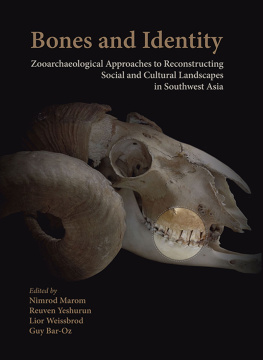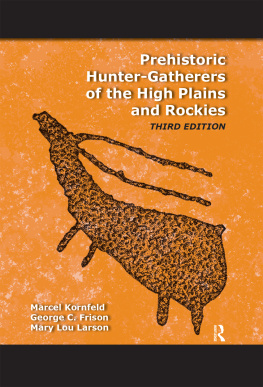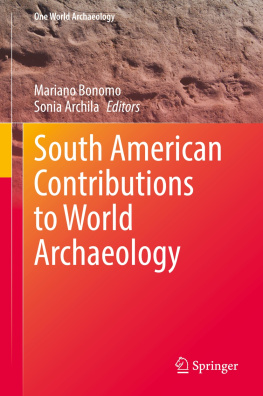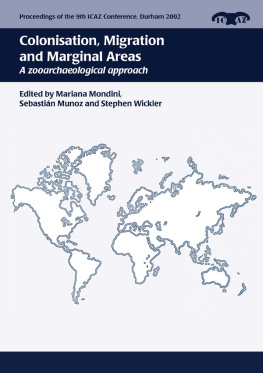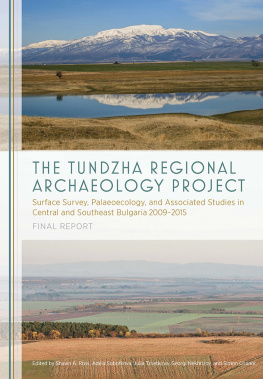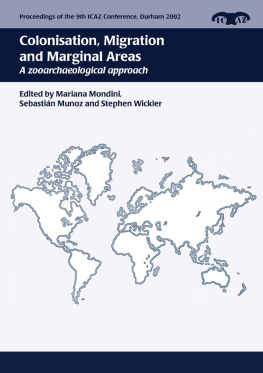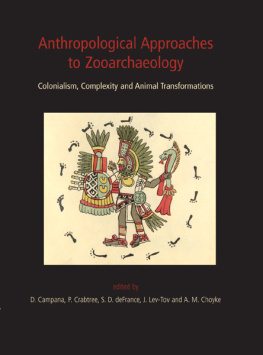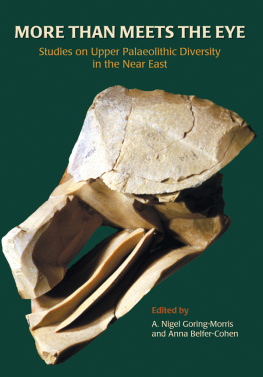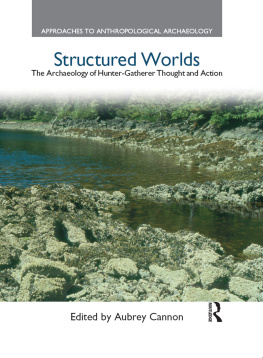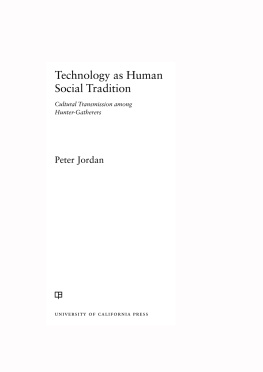Contents
R EUVEN Y ESHURUN
M IRIAM B ELMAKER AND A SHLEY B. B ROWN
B RITT M. S TARKOVICH , S IMONE R IEHL , M OHSEN Z EIDI AND N ICHOLAS J. C ONARD
C. T ORNERO , M. M OLIST AND M. S AA
H ASKEL J. G REENFIELD , T RENT C HENEY AND E HUD G ALILI
O. B AR -Y OSEF
L SZL B ARTOSIEWICZ
C ATRIONA P ICKARD
H ASKEL J. G REENFIELD , A NNIE B ROWN , I TZHAQ S HAI AND A REN M. M AEIR
G NTHER K ARL K UNST , H ERBERT B HM AND R AINER M ARIA C ZICHON
A NGELOS H ADJIKOUMIS
A RATI D ESHPANDE -M UKHERJEE , A MRITA S EN AND THE LATE L. S. R AO
N INA M ANASERYAN
H ASKEL G REENFIELD AND A NNIE B ROWN
P AM J. C RABTREE AND D OUGLAS V. C AMPANA
R AM B OUCHNIK
I NBAR K TALAV
Contributors
L SZL B ARTOSIEWICZ
Osteoarchaeological Research Laboratory, Stockholm University, Sweden. Email: .
G UY B AR -O Z
Laboratory of Archaeozoology, Zinman Institute of Archaeology, University of Haifa Israel
O. B AR -Y OSEF
Department of Anthropology, Harvard University
M IRIAM B ELMAKER
Department of Anthropology, the University of Tulsa, Oklahoma Email: .
H ERBERT B HM
Vienna Institute for Archaeological Science, University of Vienna, Vienna, Austria.
R AM B OUCHNIK
Institute for Galilean Archaeology, Kinneret Academic College; Laboratory of Archaeozoology, Zinman Institute of Archaeology, University of Haifa, Israel. Email:
A NNIE B ROWN
Department of Anthropology and St. Pauls College, University of Manitoba, Winnipeg, Canada.
A SHLEY B. B ROWN
Department of Anthropology, the University of Tulsa, Oklahoma.
D OUGLAS V. C AMPANA
Center for the Study of Human Origins, Anthropology Department, New York University, New York.
T RENT C HENEY
Department of Anthropology and St Pauls College, University of Manitoba, Winnipeg, Canada.
N ICHOLAS J. C ONARD
Senckenberg Center for Human Evolution and Paleoenvironment/Department of Early Prehistory and Quaternary Ecology, University of Tbingen, Germany
P AM J. C RABTREE
Center for the Study of Human Origins, Anthropology Department, New York University, New York.
R AINER M ARIA C ZICHON
Uak University, Uak, Turkey
A RATI D ESHPANDE -M UKHERJEE
Department of Archaeology, Deccan College Post Graduate and Research Institute, Yerawada, Pune 411006, India. Email: .
E HUD G ALILI
Israel Antiquities Authority, Caesarea Office, Israel.
H ASKEL J. G REENFIELD
Department of Anthropology and St Pauls College, University of Manitoba, Winnipeg, Canada. Email:
A NGELOS H ADJIKOUMIS
The British School at Athens, Athens, Greece. Email: .
I NBAR K TALAV
Department of Archaeology, University of Haifa, Israel. Email:
G NTHER K ARL K UNST
Vienna Institute for Archaeological Science, University of Vienna, Vienna, Austria. Email:
A REN M. M AEIR
Institute of Archaeology, Martin (Szusz) Department of Land of Israel Studies and Archaeology, Bar-Ilan University, Israel.
N IMROD M AROM
Laboratory of Archaeozoology, Zinman Institute of Archaeology, University of Haifa Israel
M. M OLIST
Seminari dArqueologia del Prxim Orient (SAPPO). Prehistory Departament, Prehistria. Edifici C. Campus Universitari. Universitat Autnoma de Barcelona, Spain. Email:
C ATRIONA P ICKARD
School of History, Classics and Archaeology, University of Edinburgh, Edinburgh. Email:
L.S. R AO ( DECEASED )
Nagpur Excavation Branch, Archaeological Survey of India, Nagpur, India
S IMONE R IEHL
Institute for Archaeological Sciences, University of Tbingen, Germany; Senckenberg Center for Human Evolution and Paleoenvironment at Tbingen, Germany
M ARIA S AA
Seminari dArqueologia del Prxim Orient (SAPPO). Prehistory Departament/Laboratori dArquezoologia, Prehistria. Edifici C. Campus Universitari. Universitat Autnoma de Barcelona, Spain. Email:
A MRITA S EN
D2 Digantika, Block AH, Sector 2, Salt Lake City, Kolkata 700091, India. Email:
I TZHAQ S HAI
Ariel University, Israel.
B RITT M. S TARKOVICH
Institute for Archaeological Sciences, University of Tbingen, Germany; Senckenberg Center for Human Evolution and Paleoenvironment at Tbingen, Germany; School of Anthropology, University of Arizona, Tucson, USA. Email:
C. T ORNERO
Archozoologie, Archobotanique: Socits, Pratiques et Environnements UMR 7209 CNRS/MNHN, Paris, France Seminari dArqueologia del Prxim Orient (SAPPO). Prehistory Departament, Prehistria. Edifici C. Campus Universitari. Universitat Autnoma de Barcelona, Spain. Email:
L IOR W EISSBROD
Laboratory of Archaeozoology, Zinman Institute of Archaeology, University of Haifa Israel
R EUVEN Y ESHURUN
Laboratory of Archaeozoology, Zinman Institute of Archaeology, University of Haifa Israel. Email:
M OHSEN Z EIDI
Senckenberg Center for Human Evolution and Paleoenvironment/Department of Early Prehistory and Quaternary Ecology, University of Tbingen, Germany
Introduction: Animal Bones and Cultural Identity in the Archaeology of Southwest Asia
Nimrod Marom, Reuven Yeshurun, Lior Weissbrod and Guy Bar-Oz
The concept of Bones and Identity applying the toolbox of archaeozoology to the reconstruction of socio-cultural diversity in antiquity offers an especially powerful integrating theme in the archaeozoology of southwest Asia. This region boasts a long and intensely researched sequence of cultural evolution, especially between the rise of early sedentary hamlets to that of empires, and forms one of the worlds hot-spots of archaeological research, beginning more than 150 years ago. Here, in particular, the endeavour to attach a face and a name to the material remains which are studied by archaeologists has long served as a catalyst for devising methods to detect the presence of discrete socio-cultural groups and reconstruct their respective economies, politics and environments from specific material fingerprints.
In recent decades, animal remains have emerged as one of the more promising approaches to the exploration and systematic study of socio-cultural identity as expressed through ancient practices of meat consumption a universal human activity which has always bound together considerations of ecology, economy, social class, religion, and ethnicity and has relevance for investigating different sections of ancient societies. Unlike many other categories of ancient material culture, animal remains reflect simultaneously patterns of subsistence, politics, and self-identification and provide researchers with particularly rich repositories of data.
Bones and Identity was chosen by us as the leading theme for the 11th Meeting of the Archaeozoology of Southwest Asia and Adjacent Regions held at the University of Haifa in June 2013. This volume, providing the proceedings for the conference, brings together 17 papers written by archaeozoologists working mainly in southwest Asia, but also in neighbouring regions between Greece in the west and India in the east. Its temporal scope spans the Paleolithic to the Middle Ages, providing an overview of the conceptual and methodological approaches employed to tackle complex issues of diversity and identity in social systems an especially challenging task for practitioners which often work as collaborators in excavation projects lacking an explicit research design focused on these questions. The papers in this volume present a realistic notion of what can be accomplished through a Bones and Identity-oriented archaeozoological research programme as well as of the limitations of such research within the framework of projects carried out in southwest Asia.

